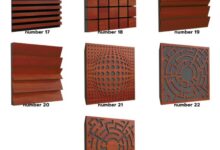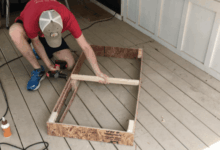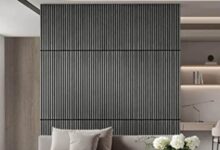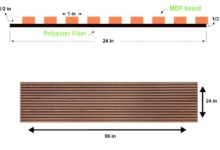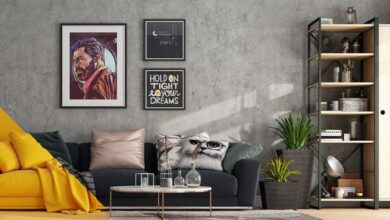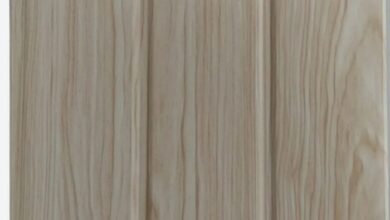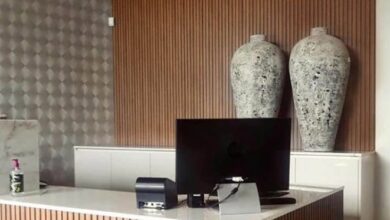How Durable is Vinyl Siding? A Comprehensive Guide
How Durable is Vinyl Siding? This comprehensive guide delves into the longevity of vinyl siding, exploring its construction, environmental impact, installation, maintenance, and comparison to other materials. Understanding its strengths and weaknesses, along with potential problems and solutions, empowers homeowners to make informed decisions about this popular siding choice.
From the initial selection of smooth or textured vinyl to the crucial role of proper installation and regular maintenance, this in-depth analysis covers all the key factors affecting vinyl siding’s lifespan. We’ll also compare its durability against traditional materials like wood and fiber cement, providing a clear picture of its long-term value.
Introduction to Vinyl Siding Durability
Vinyl siding, a popular choice for exterior home renovations, offers a compelling blend of aesthetics and practicality. Its durability stems from a combination of its material composition and construction methods. This material, a composite of polyvinyl chloride (PVC), provides a resilient barrier against the elements, contributing to its long lifespan. Understanding the construction and variations within vinyl siding is key to appreciating its overall durability.Vinyl siding’s inherent resistance to rot, insects, and the damaging effects of moisture, combined with its ability to withstand extreme temperatures, significantly contributes to its longevity.
This makes it a cost-effective solution for homeowners seeking a low-maintenance exterior. Furthermore, the manufacturing process and design features of vinyl siding play a significant role in its ability to withstand weathering.
Types of Vinyl Siding and Durability
Different types of vinyl siding are designed to meet various aesthetic and functional needs. The variations in texture, profile, and color options available contribute to its popularity. The durability of these types can vary, influenced by their design features and manufacturing processes.
- Smooth vinyl siding typically offers a sleek and modern look. Its smooth surface minimizes the accumulation of debris, which can lead to better water drainage and reduced risk of mold or mildew growth. However, smooth siding might be more susceptible to dents or scratches compared to textured options.
- Textured vinyl siding often incorporates grooves, ridges, or other surface patterns. These textures improve the siding’s resistance to dents and scratches, providing a more resilient exterior. However, textured surfaces might accumulate more debris, potentially requiring more frequent cleaning.
- Board-and-batten vinyl siding mimics the look of traditional wood siding, offering a charming and classic aesthetic. This style typically combines vertical boards with horizontal battens. Its durability is generally comparable to smooth or textured siding, depending on the specific design and quality of the product. However, it might be more susceptible to damage from impact compared to a solid panel design.
You also can understand valuable knowledge by exploring Luxury Hotels in Mecca Near the Grand Mosque.
Comparative Analysis of Vinyl Siding Types
The table below provides a concise comparison of different vinyl siding types, highlighting their strengths and weaknesses.
| Siding Type | Strengths | Weaknesses |
|---|---|---|
| Smooth | Sleek appearance, minimal debris accumulation, good water drainage | More susceptible to dents and scratches, potentially less impact-resistant |
| Textured | Increased resistance to dents and scratches, more resilient to impact | More debris accumulation, potentially requiring more frequent cleaning |
| Board-and-batten | Classic aesthetic, good balance of durability and appearance | May be more susceptible to damage from impact compared to solid panels, may accumulate debris in joints |
Environmental Factors Affecting Durability: How Durable Is Vinyl Siding
Vinyl siding’s lifespan isn’t solely determined by its material composition; external factors play a crucial role. Understanding how weather conditions and geographical location impact durability is essential for homeowners considering this popular exterior cladding option. Proper maintenance and selection of siding can significantly extend its lifespan and aesthetic appeal, mitigating the effects of environmental stressors.Environmental factors significantly influence the longevity and performance of vinyl siding.
Exposure to various weather elements, including sunlight, rain, snow, and temperature fluctuations, directly impacts its resilience and aesthetic appeal. Geographical location, particularly the climate and prevalent weather patterns, further affects the material’s durability over time.
Sun Exposure and UV Degradation
Prolonged sun exposure accelerates the breakdown of vinyl siding, leading to discoloration and eventual degradation. Ultraviolet (UV) radiation from sunlight causes the vinyl’s polymer chains to weaken, leading to cracking, fading, and loss of its initial sheen. The intensity and duration of sunlight exposure greatly affect the degradation rate. Areas with higher solar radiation experience faster degradation than those in shaded or less sunny locations.
Choosing vinyl siding with UV inhibitors can help mitigate this effect, prolonging its lifespan.
Effects of Rain, Snow, and Temperature Fluctuations
Rain and snow can cause water damage, which can lead to mold, mildew, and rot. Repeated cycles of freezing and thawing, common in areas with fluctuating temperatures, can cause the siding to expand and contract, potentially leading to cracking or detachment. The accumulation of water behind or within the siding can also create a breeding ground for mold and mildew.
Appropriate drainage systems and proper installation techniques are essential to minimize the negative effects of these weather elements.
Impact of Extreme Weather Events
Extreme weather events like hurricanes and hailstorms can cause significant damage to vinyl siding. High winds can tear away loose panels, while hail can cause dents and scratches, compromising the siding’s integrity and appearance. The severity of damage often correlates with the intensity of the storm. Installing sturdy fasteners and ensuring proper overlap between panels are crucial steps in enhancing the siding’s resistance to extreme weather conditions.
Reinforced installation methods are particularly crucial in high-wind zones.
Geographical Location and Climate Influence
Geographical location plays a significant role in determining vinyl siding’s durability. Coastal areas with high humidity and salt spray experience more rapid degradation due to corrosion. Similarly, mountainous regions with extreme temperature fluctuations can cause significant expansion and contraction stress. Areas prone to heavy snowfall or high winds might require specific considerations in installation and material selection.
Durability Comparison Across Climates
| Climate | Durability Considerations | Expected Lifespan (Approximate) |
|---|---|---|
| Coastal (High Humidity, Salt Spray) | Increased risk of corrosion, requires specialized materials and installation techniques. | 15-20 years |
| Mountainous (Extreme Temperature Fluctuations) | Increased risk of expansion and contraction, needs robust fastening and proper insulation. | 20-25 years |
| Temperate (Moderate Temperatures, Rainfall) | Relatively favorable conditions for vinyl siding. | 25-30 years |
| Desert (High Temperatures, Low Humidity) | High UV exposure can accelerate degradation, requires UV-resistant materials. | 20-25 years |
Note: These are approximate lifespans and can vary based on specific material quality, installation practices, and homeowner maintenance.
Installation and Maintenance Practices
Proper installation and regular maintenance are crucial for the longevity of vinyl siding. These practices significantly impact the durability and aesthetic appeal of the siding, minimizing potential damage and extending its lifespan. Neglecting these aspects can lead to premature deterioration and costly repairs.High-quality vinyl siding, when installed correctly and maintained regularly, can last for decades, requiring minimal intervention.
This comprehensive guide delves into the specifics of installation techniques, maintenance schedules, and common pitfalls to help homeowners ensure their investment remains a reliable and attractive feature of their home.
Proper Installation Techniques
Correct installation is paramount to the long-term durability of vinyl siding. Substandard installation can lead to problems such as warping, cracking, and premature failure. Employing skilled professionals with experience in vinyl siding installation is essential to avoid these issues. Thorough adherence to manufacturer’s specifications is vital.Careful measurements, precise cuts, and proper fastening are key components of a strong and lasting installation.
Ensuring proper drainage is also critical to prevent water damage, a frequent cause of vinyl siding failure. Use of appropriate flashing and weather-resistant sealant around windows and doors is imperative to maintain a watertight seal. This prevents water from seeping behind the siding, causing rot and damage.
Importance of Regular Maintenance, How Durable is Vinyl Siding
Regular maintenance is crucial to preserving the integrity of vinyl siding. This proactive approach helps identify and address minor issues before they escalate into major problems. This often translates to lower repair costs and a longer lifespan for the siding.Regular inspections are vital to detect early signs of damage, such as loose panels, cracks, or discoloration. This allows for timely repairs and prevents the spread of damage.
Cleaning and inspecting the caulking and sealants around windows and doors is also a key aspect of preventative maintenance.
Common Installation Mistakes
Several common mistakes can compromise the durability of vinyl siding. Improperly sized or installed fasteners can lead to loose panels and gaps over time. Using inadequate sealant around windows and doors can lead to water damage and rot. Failure to account for expansion and contraction can also result in cracking. Insufficient or inappropriate ventilation can also compromise the quality of the installation and siding.
How to Properly Clean and Maintain Vinyl Siding
Regular cleaning is a fundamental aspect of vinyl siding maintenance. A simple solution of mild detergent and water is usually sufficient. Avoid harsh chemicals or abrasive materials, which can damage the siding’s surface. Thorough rinsing is essential to remove any residue.Cleaning should be performed at least twice a year, or more frequently depending on environmental conditions. Cleaning helps maintain the siding’s aesthetic appeal and prolongs its lifespan by removing dirt, mildew, and other contaminants that can accumulate.
A soft brush or sponge is recommended for cleaning.
Comprehensive Vinyl Siding Maintenance Schedule
| Month | Activity |
|---|---|
| Spring (March-May) | Thorough inspection for loose panels, cracks, and damage. Clean siding to remove accumulated debris from winter. |
| Summer (June-August) | Inspect for signs of mold or mildew. Clean siding again if necessary. |
| Autumn (September-November) | Check for damage caused by fallen leaves or other debris. Clean siding once more. Inspect caulking and sealants around windows and doors. |
| Winter (December-February) | Inspect for damage from ice and snow. Assess siding for potential water damage. Consider preventative measures against potential winter weather damage. |
Durability Compared to Other Siding Materials
Vinyl siding’s durability stands out as a significant factor in its popularity, but how does it stack up against other common siding materials? This section delves into a comparative analysis of vinyl siding’s longevity against wood, aluminum, and fiber cement siding, examining their respective strengths and weaknesses. Understanding the long-term costs associated with each material is crucial for informed decision-making.Different siding materials offer distinct advantages and disadvantages, influencing their suitability for various climates and budgets.
Each material has a unique lifespan, maintenance requirements, and susceptibility to environmental damage. Analyzing these factors allows homeowners to make an informed choice that aligns with their specific needs and circumstances.
Comparing Vinyl Siding to Wood Siding
Wood siding, a classic choice, presents a natural aesthetic. However, its susceptibility to rot, insect damage, and weathering significantly impacts its long-term durability. Vinyl siding, on the other hand, resists these elements, providing a far more resilient and low-maintenance option. While wood siding requires frequent painting and sealing to maintain its appearance, vinyl siding typically only needs occasional cleaning.
Comparing Vinyl Siding to Aluminum Siding
Aluminum siding is known for its strength and resistance to dents and impacts. However, it can be prone to fading or discoloration over time. Furthermore, aluminum’s inherent reflectivity can lead to significant temperature fluctuations, potentially impacting the comfort of the home. Vinyl siding, while not as strong in terms of impact resistance, offers consistent color retention and lower thermal conductivity, which contributes to more stable indoor temperatures.
Comparing Vinyl Siding to Fiber Cement Siding
Fiber cement siding is a durable material known for its resistance to fire, insects, and moisture. Its strength and resilience make it suitable for various climates. However, fiber cement siding typically comes with a higher upfront cost compared to vinyl. Vinyl siding, despite its lower cost, can still offer comparable durability in many instances, especially when considering its low maintenance needs.
Long-Term Costs of Different Siding Types
Understanding the long-term costs associated with each siding type is crucial for informed decisions. Factors such as initial cost, ongoing maintenance, and eventual replacement must be factored in.
| Siding Material | Initial Cost | Maintenance Costs | Replacement Frequency | Total Lifecycle Cost |
|---|---|---|---|---|
| Vinyl | Moderate | Low | 25-30 years | Low |
| Wood | Moderate | High | 10-15 years | High |
| Aluminum | High | Low to Moderate | 25-30 years | Moderate |
| Fiber Cement | High | Low | 30-40 years | High |
Note: Lifecycle costs are estimated and can vary based on specific factors like location, climate, and maintenance practices.
Identifying Potential Problems and Issues
Vinyl siding, while a popular and durable exterior option, can be susceptible to various issues over time. Understanding these potential problems and their causes is crucial for maintaining the longevity and aesthetic appeal of your home’s exterior. Proper identification and timely repair are key to preventing further damage and costly replacements.
Common Problems Affecting Vinyl Siding Durability
Vinyl siding, despite its resilience, is susceptible to certain problems that can compromise its structural integrity and appearance. These issues often stem from environmental factors, improper installation, or insufficient maintenance. Identifying these problems early allows for prompt intervention and minimizes long-term damage.
Warping
Warping, characterized by the bowing or twisting of vinyl siding panels, is a common issue. It can be triggered by temperature fluctuations, especially in areas with significant temperature swings. Exposure to prolonged direct sunlight or improper installation practices can also contribute to this problem. Addressing warping requires careful inspection of the installation method, identifying and correcting any underlying issues.
Properly installed vinyl siding with appropriate expansion joints will help mitigate warping.
Cracking
Cracking in vinyl siding can occur due to impact damage or excessive stress from extreme weather events. Repeated cycles of freezing and thawing, especially in areas with harsh winters, can also lead to hairline cracks in the siding material. These cracks, initially small, can expand and compromise the siding’s structural integrity. Thorough inspections during and after inclement weather can help in identifying and rectifying potential cracking issues early on.
Reinforcing the siding at points of stress, such as corners and joints, can help prevent future cracking.
Discoloration
Discoloration, including fading or staining, can be a cosmetic concern. Prolonged exposure to ultraviolet (UV) rays from sunlight is a primary cause of fading. Mold or mildew growth, especially in areas with high humidity, can also contribute to discoloration. Regular cleaning and protective coatings can help mitigate these issues. Choosing siding with enhanced UV resistance is an important consideration, especially in high-sun regions.
Table of Common Vinyl Siding Problems and Solutions
| Problem | Causes | Solutions |
|---|---|---|
| Warping | Temperature fluctuations, improper installation, inadequate expansion joints | Inspect installation, ensure proper expansion joints, address underlying issues, use weather-resistant materials |
| Cracking | Impact damage, extreme weather, stress from expansion/contraction | Reinforce vulnerable areas, repair or replace damaged sections, address structural issues, inspect after storms |
| Discoloration | UV exposure, mold/mildew growth, poor cleaning practices | Regular cleaning, protective coatings, use UV-resistant materials, address humidity concerns |
Longevity and Lifespan Estimates
Vinyl siding, a popular choice for its affordability and low maintenance, offers a significant return on investment when considering its durability. Understanding its lifespan under various conditions is crucial for homeowners making informed decisions. Predicting the precise duration of a vinyl siding installation is complex, influenced by numerous factors beyond initial purchase.
Realistic Lifespan Estimates
Vinyl siding’s lifespan is typically measured in decades, not years. A properly installed and maintained vinyl siding system can last for 20 to 50 years or more. The actual duration depends on a multitude of variables, from climate conditions to installation quality and homeowner maintenance. This variability makes it essential to factor in potential long-term costs and the need for eventual replacement.
Factors Influencing Lifespan
Several factors contribute to the longevity of vinyl siding:
- Climate Conditions: Extreme temperatures, heavy rainfall, and harsh weather conditions can accelerate degradation. Areas with high humidity or frequent temperature fluctuations might experience a shorter lifespan. For example, coastal regions with salt-laden air can quickly erode the siding’s surface, requiring more frequent maintenance.
- Installation Quality: A poorly installed system is more susceptible to damage and premature failure. Correct installation, including proper fastening and sealing, is vital for a long lifespan. A professional installation minimizes stress points and reduces the risk of warping or cracking.
- Maintenance Practices: Regular cleaning and inspection can significantly extend the lifespan of vinyl siding. Removing debris, addressing any signs of damage, and using suitable cleaning agents will help prevent premature deterioration.
- Product Quality: Different manufacturers use various formulations and production processes. Higher-quality vinyl siding, often with added UV stabilizers, is better equipped to withstand harsh conditions and maintain its integrity for a longer period. Some high-quality materials have a warranty of 20 years or more.
Determining Siding Age and Remaining Lifespan
Determining the age of vinyl siding involves careful inspection. Visual cues such as discoloration, warping, or the presence of cracks can indicate the material’s age and potential for deterioration. Professional assessments can provide a more precise evaluation, including analysis of the siding’s original installation documentation and inspection of the installation techniques.
Potential Lifespan Table
The table below provides a general guideline for the potential lifespan of vinyl siding based on various climate conditions and installation factors. Actual results may vary.
| Climate Zone | Installation Quality | Potential Lifespan (Years) |
|---|---|---|
| Mild, Dry Climate | Excellent | 25-40 |
| Mild, Humid Climate | Good | 20-35 |
| Coastal, Salt-laden Air | Excellent | 15-25 |
| Cold, Snowy Climate | Excellent | 20-30 |
| Severe Weather Zones | Excellent | 15-25 |
Visual Representation of Durability
Vinyl siding’s longevity is directly tied to its visual appeal. Understanding how it changes over time, from pristine new installation to potential degradation, is crucial for homeowners. This visual representation will demonstrate the impact of various factors on its appearance.Visual representation of vinyl siding’s performance throughout its lifespan provides a tangible way to understand its durability. A series of images, along with detailed descriptions, allows for a clear understanding of the effects of environmental factors and maintenance practices on the siding’s aesthetic integrity.
Stages of Vinyl Siding Degradation
A comprehensive understanding of vinyl siding’s visual transformation over time can help homeowners make informed decisions about maintenance and potential replacements. The following series of stages illustrates the progression from new installation to degradation.
- Initial Installation (Year 0): The siding is pristine, showcasing a uniform color and texture. No signs of damage or discoloration are evident. The surface is smooth and free from blemishes.
- Years 1-5: The siding exhibits minimal change, maintaining its original appearance. Minor surface variations might be present, but the overall condition remains excellent. Regular cleaning and maintenance are evident.
- Years 6-10: Slight discoloration or fading, particularly in areas exposed to direct sunlight, may be noticeable. Minor surface imperfections, such as very light scratches or hairline cracks, might appear in areas of high impact.
- Years 11-15: Fading and discoloration are more pronounced, potentially affecting a larger portion of the siding surface. Surface imperfections become more visible, including some pitting or cracking in areas exposed to extreme weather conditions or poor installation. The siding’s structural integrity is still intact.
- Years 16-20: Significant discoloration and fading are evident. Surface imperfections, including deep scratches, significant pitting, and potential cracking, become widespread. The siding’s original aesthetic is significantly altered. Potential for early signs of structural compromise is evident, but not necessarily present.
- Years 21-25+: Extensive discoloration and significant damage are visible, including extensive cracking and potential detachment in areas subjected to repeated impacts or prolonged exposure to harsh weather. The siding’s protective barrier is compromised, and repair or replacement is likely required to maintain the integrity of the structure.
Examples of Well-Maintained and Poorly Maintained Siding
Illustrative examples demonstrate the impact of consistent care on vinyl siding’s appearance.
- Well-Maintained Siding: Images showcasing well-maintained vinyl siding would depict a uniform color, minimal fading, and a smooth surface. Regular cleaning and protective measures are evident. These examples highlight the long-term aesthetic appeal achievable with proper maintenance.
- Poorly Maintained Siding: Examples of poorly maintained vinyl siding would show noticeable discoloration, extensive fading, and visible damage. Areas exposed to the elements, such as gutters or overhangs, would demonstrate more pronounced degradation. These examples illustrate the consequences of neglecting regular maintenance and cleaning.
Appearance Across the Lifespan
The appearance of vinyl siding changes significantly throughout its lifespan.
| Stage | Appearance | Impact |
|---|---|---|
| New Installation | Uniform color, smooth surface, no visible damage | Excellent aesthetic, pristine condition |
| Mid-Lifespan | Slight discoloration, minor surface imperfections | Minimal aesthetic change, still functional |
| Advanced Lifespan | Significant discoloration, extensive damage, potential detachment | Aesthetically compromised, structural integrity may be threatened |
Conclusive Thoughts
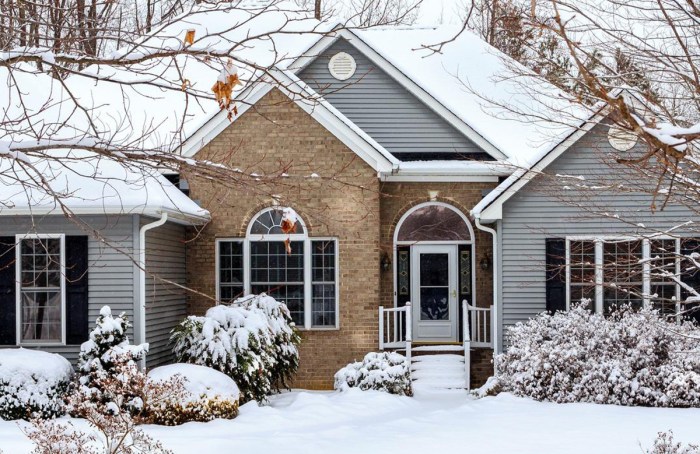
In conclusion, vinyl siding offers a compelling blend of affordability, durability, and low maintenance. Its resilience against weather elements and relatively straightforward maintenance make it a popular choice for homeowners. However, understanding the nuances of different vinyl types, installation best practices, and potential environmental factors is crucial for maximizing its lifespan. This guide provides a detailed roadmap for homeowners seeking to leverage the full potential of vinyl siding, ensuring years of lasting protection and aesthetic appeal for their homes.
